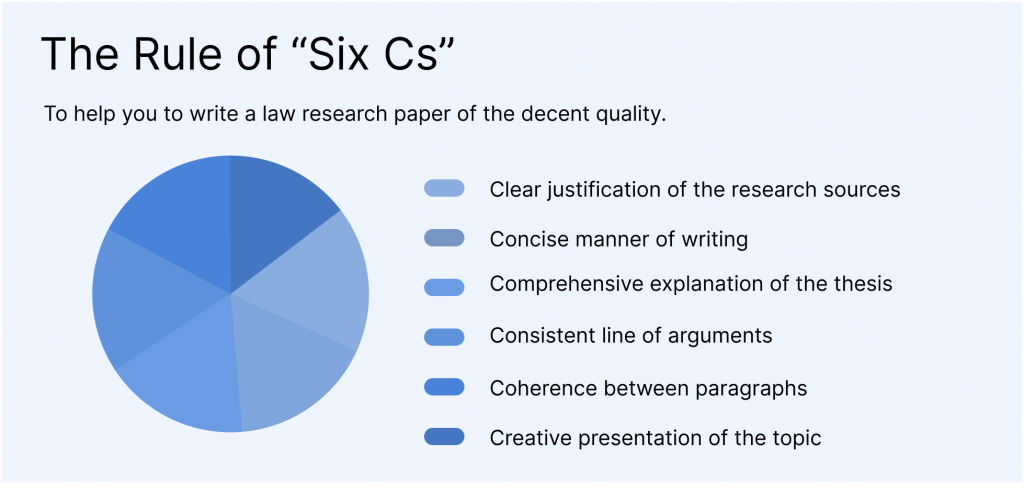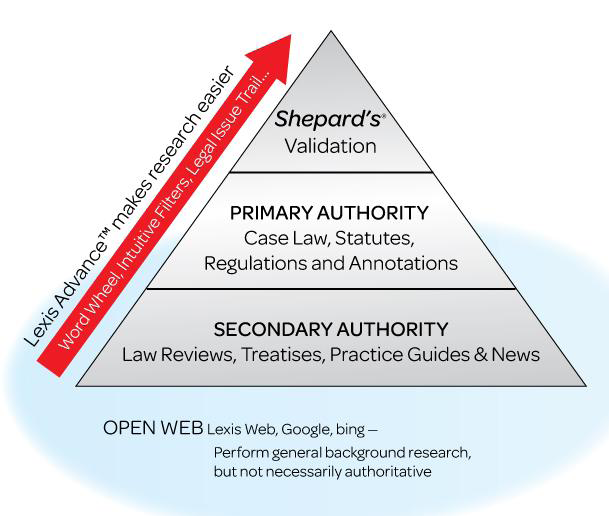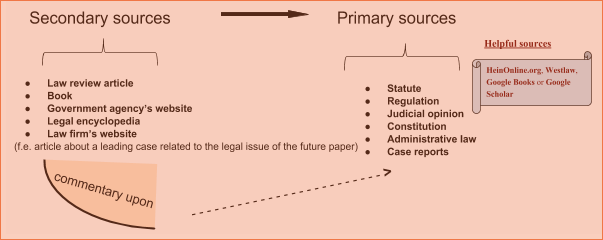If one looks up the word “research” in the Oxford English Dictionary, he/she will find that it is ‘the systematic study of materials and sources in order to establish facts and reach new conclusions’. This definition leads most students to the erroneous implication that legal research is daunting and too challenging for them. To the mind of most, this kind of work is only for theoreticians and academicians. In fact, the field of law has plenty of interesting issues to investigate on paper. Once a student finds the topic that is worth of looking into, the idea of exploring it gets more exciting. Researching a particular issue means learning the background, tracing the history of the legislation, finding out professional opinions of legal scholars and eventually coming up with the ideas/suggestions in a given area.
Research is a great legal experience, and, moreover, is a starting point of every lawyer’s career. Most studies show that legal research skills are the first requirement on the employer’s list. As legal research can seem a real conundrum at first, this law research paper writing guide may provide you with Custom law assignment to shed some light on it.
3 Pre-Writing Tips for a Law Research Paper
Before starting to write a research paper in Law, it is better to get well-prepared for the writing process, namely, you’re highly recommended to:
- Read some legal pieces of research. If you are a novice in legal research, looking through the studies of lawyers or scholars will ease the task. The more papers you read, the more you will know about the structure and peculiarities of this kind of work. It will be also easier to pick the topic for the future research after getting familiar with a various legal issues. If the research topic matches the topic of the sample, the source problem will be considered to be solved.
- Use some effective research methods. This kind of work requires more than Google. Even though online-searching is fast, flexible and provides more updated information than printed publications (for example, current court decisions), it is not helpful when looking for background information or broad legal notions. It can also be hard to follow cross-referencing and annotation references via a computer. Besides, most legal bases used by law offices are not in public access or extremely expensive.
- Outline all the found information. After having all the information in hand, it is useful to outline it by highlighting the main ideas of research and pointing out the supporting details. Focus on the data to inform the reader about a specific legal topic. Remember students who don’t understand the benefits of outlining a research paper think it is a waste of time. In contrast to this wrong opinion, it will save your time later when you start law research paper writing.
Don’t skip the prewriting process to start and finish successful writing a research paper in Law. Focus on the following research points that are essential for you as a good researcher:
- Research process. First of all, it is important to realize that legal research is a process. It takes time, a thorough analysis, the full concentration, and close attention to details. There are some stages of the legal research cycle:

- Research strategy. This simple plan can assist you as the author of a good research paper with the information-gathering process:

When tackling an organization of working on legal topics for research papers, one better remember the principle of maximum effect with minimal effort. It means that chosen methods must allow some objectives to be accomplished quickly. It is equally crucial for a learner and a scientific researcher to understand how to navigate their schedule and budget limits rationally.
Taking this principle, an extra set of rules might be of particular help:
- Before the work begins, you need to concentrate on the subject of study, putting all current worries aside. Switch to the scope and purpose of the work (focusing first aid is to tidy up your workplace).
- It is vital to work intensively. The habit of “procrastinating” at the very start is particularly harmful when working on legal studies research paper series. The legal scholarship network is quite competitive and demanding, pushing authors to be novel, original, and fast enough to be one step ahead of other researchers.
- In the work process, you need to reject all side thoughts and associations and think only about the work.
An intensive work format creates ideal conditions for focusing attention. A researcher who works intensively does not react to outside stimuli.
From a methodological perspective, improving mental work organization is primarily about constructive perception, processing, and assimilation of knowledge.
Tips from Our TOP Academic Writers on How to Structure a Law Research Paper
There is no formula for a successful legal research paper. However, there are some basic characteristics that constitute a decent paper. A proper structure is one of the most important features necessary for you as a good writer. Even though a research paper in law has a specific nature, its general structure is confined to the introduction, main body, and conclusion. If making your paper’s structure logical and concise is a tough task for you, look for help online. Text professionals something like research paper writer, and see how specialists work magic. It is important to remember that it is simply a guidance and example of how to approach the work on law essay topics. It means that you cannot submit the sample as your own work. Specialists show you the ropes, you learn, and then enjoy the ease of a mastered art of covering most, if not all, law paper topics.
Introduction of a research paper
A well-written introduction is crucial for your research paper. A quick glance over the first paragraphs gives the reader an idea of what the work is about. The reader can quickly evaluate whether it is worthy of reading the entire text by looking through the introduction. The introduction must clearly express the research problem and define the scope of the inquiry. Besides, the introduction needs to contain background information regarding the issue the author is addressing in the paper. This part serves as a foundation for further consideration, not a place to develop the argument. Thus, three main points to be outlined in the introduction:
- the reasons why this legal issue is worth a reader’s attention,
- the gaps in the current knowledge,
- the purpose of the study.
Despite the wide range of the points to be mentioned in this section, it does not need to be lengthy. Stick to 10-15% of the length of the whole paper.
Main body of a research paper
The focal point of the research paper is the main body. Since it is the most extensive part, it should be divided into sections. To present the material in a clear and comprehensible manner for the reader, each section should begin with a heading and the purpose it is expected to pursue. Paragraphing will help to organize the thoughts so that the reader can easily follow the flow of ideas. Each paragraph should begin with a topic sentence. If the reader without knowledge in this particular area understands the paper when reading only the topic sentence, the mission of the author is accomplished. Besides, each paragraph should be completed with a concluding sentence, drawing out the main points discussed in the paragraph. The content of the main sections of the paper is supposed to answer the question the author raised in the introduction.
Meanwhile, to truly succeed when working on law research topics, it is critical to acquaint yourself with the methodology of legal science. The one has several levels:
- First, the worldview level that determines the leading directions and general principles of learning;
- Second, the interdisciplinary level, which enters the game when you learn a specific group of objects sharing its type;
- Third, specifically-scientific level, which is used in the process of learning the details of an individual object through the lenses of multiple sciences;
- Fourth, the subjective-scientific level is primarily inherent to studying law topics objects and their unique qualities within the limits of one specialization;
- Fifth, procedural level, including methods peculiar to each project in the research paper series.
You can notice an organic connection and interdependence between the levels of legal science methodology. The sets of theories and categorical apparatus occupy the central place. Legal theory, when used in law research paper topics covering state-legal phenomena, turns into a scientific method. The specifics of its use depend on the attributes of the theory, its objective, and its conceptual basis. Operating as a method of scientific knowledge, it allows for a thorough description of state-legal phenomena. The theory also assists with identifying and examining their new properties and envisioning phenomena’ development, serving as proof and criterion of its validity.
The conclusion of a research paper
The final part of the research paper should be a summary of the main points stated in the law study. However, the conclusion should not be made of the phrases copied from the main body or the introduction. Logical consistency with the arguments explained in the main part is crucial. Moreover, no new arguments can be introduced in this part.
Note: Even though it seems logical to write the introduction first, it is virtually impossible to do before there is a clear argument which takes place in the main part of the paper. Therefore, the introduction should be written when the author knows where his/her argument is going. In other words, it should be written after the main part writing is finished.
Intro-body-conclusion are three key points to developing a coherent and concise paper. You can play around with their content, like trying different “hooks” for the introduction or developing a sub-structure for body paragraphs. However, always adhere to these three parts to write good research.
How to Form a Reference List for a Research Paper in Law
A reference page lists all the sources that are used in the research paper. Whether the information is taken from the book, websites, or journals, it should be correctly referenced, so that the reader can easily retrieve it. It is necessary for a writer to make sure to note every source for the paper. The practical experience shows that students tend to remember about referencing after paraphrasing. As a result, the needed web pages are closed, and book pages are lost.
The basic requirements of the reference page are the following:
- Each reference should be formatted according to the appropriate style guide (MLA, APA, Chicago, etc.) The styles peculiarities shouldn’t be mixed;
- The reference page should be organized in alphabetical order according to the authors’ last names;
- Every resource that is used in the paper should be on the reference page. If one item is missing from the list, the paper can be considered plagiarism;
- Correct formatting, namely spacing, and indentation, should be taken into account.
The example of an APA reference:
Derwing, T. M., Rossiter, M. J., & Munro, M. J. (2002). Teaching native speakers to listen to foreign-accented speech. Journal of Multilingual and Multicultural Development, 23(4), 245-259.
A clear focus on the topic (subject) and its central questions (chapters and subsections in law research papers) will speed up the purposeful selection of literature for the Reference List. Reading stimulates ideas. A meticulous reading of any text “charges” the thinking process. It helps formulate hypotheses that conform to one’s presumptions. The study of sources can be split into phases:
- First, you get a general view of a scientific problem in research paper law.
- Second, you proceed with the cursory review of the fixed list of literature. You systematize it following the content of the legal research papers and the study parts sequence. Examples of the content’s organization could be found on such platforms as vLex, HeinOnline, Jstor, and SSRN. Or you may simply google Law Review Handbook and pick one according to your location.
- Third, you embark on a reading journey sticking to the structure’s sequence of your work, meaning that it is better to read sources for one chapter of your work before switching to the sources containing information on the subject of another chapter.
- Fourth, you selectively read the sources highlighting paragraphs that are presumably most applicable to your work.
- Fifth, you define the relevant material for composing the text of a research paper law.
- Sixth, you critically evaluate the recorded titles on the list, edit them, and finalize the list as an element of writing a legal research paper.
There is an alternative method to process literary sources. Divide a sheet of paper in half using a vertical line. On the left side, write down the titles of what you have read. On the right side, present your comments and highlight noteworthy formulations. It is essential to simultaneously complete bibliographic reports on the sources and respective subject headings codes. The latter must correspond to the scientific project sections.
Keeping records when reading collected publications is mandatory. It enriches the comprehension of what you have read. The primary point here is to document an idea about a particular source and forecast the future need for the data from one when the law paper is in progress.
The Rule of “Six Cs” Helps You to Write a Research Paper
The rule implies that the research writing should be done in a clear, concise, and comprehensive manner. The legal terminology is sophisticated and most legal materials are written in a complex language. Therefore, the idea of legal research is to filter out unnecessary information, and chose the relevant material, systemize it and provide it in a simple and direct manner. The ability to write accurately and effectively is equally as important as research skills.
Two more “c” – consistency and coherency help you out
The support by evidence is essential to legal research writing. Every argument should not be determined by emotions or prejudices, but be based on reasons and facts. Despite the division into parts, sections, and paragraphs, all the components need to be consistent, forming a coherent paper. Only one issue can be brought up, developed logically, and lead to a comprehensible conclusion.
Evidence quality reflects the level of a law school research paper and the practical substance of collected cases and precedents. One of the most critical aspects is data provision. It marks the process when researchers explore various databases looking for pearls of scientific information. The researchers will need their findings to deconstruct and analyze the subject comprehensively.
Building up an information background is the first stage of any research. At the same time, the completeness and quality of the accumulated materials have a powerful impact on the analysis and its results. The basis of any school research paper is information. The latter represents a collection of facts and details determining the level of knowledge about certain phenomena, events, and associations connecting them.
Undoubtedly, information remains one of the basic concepts of science. In the legal research topic, the specifics of the data the authors obtained are paramount: it determines whether the argument will be winning. Hence, it is critical for the gathered information pieces to be:
- Adequate and show compliance with actual procedures and objects;
- Relevant and comply with the objectives for which it is intended;
- Correct, with presenting approach reflecting the content;
- Accurate, displaying phenomena with minimal error;
- Applicable, reflecting the high potential of its use today;
- General and independent from individual adaptations when working on the law topics for research paper.
In the end, the more detailed the work, the better.
The final “c” stands for creativity
The phrase “New – in every discipline – means never joined before” stated in The Advertising Solution by Craig Simpson and Brian Kurtz. In turn, Kate Dewhirst, a lawyer, is sure that a legal innovation is able to unlock creativity. Whereas most students tend to think that legal area is not a place to be creative or innovative, it is still possible to use these skills to write a remarkable research paper. Creativity is a key component to being an outstanding lawyer. The only thing a writer has to do is to connect things in a way they have never been connected before.

To Quote or Not to Quote: That Isn’t the Question in Law
Law is an area where you aren’t allowed to avoid quotations from the constitution, for example. So the question, “To quote or not to quote?” is positively answered for you – underpin your position as a researcher by means of strong evidence. When it comes to choosing between direct quotations or paraphrasing, it is important to define in which cases direct quotes should take place:
- When they set out the enacted law
For example, quoting the exact language of the Universal Declaration of Human Rights is preferable to paraphrasing, since the latter can differ dramatically from the meaning of the words in their original context.
Article 12.
“No one shall be subjected to arbitrary interference with his privacy, family, home or correspondence, nor to attacks upon his honor and reputation. Everyone has the right to the protection of the law against such interference or attacks”.
According to the Universal Declaration of Human Rights, no one can invade someone’s privacy, nor harm someone’s reputation.
- If they are fewer than three lines,
- If they happen to be longer than three lines, it is important to set off that quote in a block format.
Common mistake: When quoting from sources, it is crucial not to take the quotations out of context. Quoting out of context takes place when a passage is removed from what is said before, and, as a result, the intended meaning is distorted.
For example, the following quotation is taken out of context:
‘According to Chief Justice John Roberts, this President’s words strike at fundamental standards of respect and tolerance, in violation of our constitutional tradition.
The original quote is taken from CNN Politics:
“Plaintiffs argue that this President’s words strike at fundamental standards of respect and tolerance, in violation of our constitutional tradition.’
Whereas the writer uses several phrases exactly as they appear in reality and does not change the structure, the meaning differs dramatically.
2 Post-Writing Tips for Your Research Paper
No research paper is considered to be completed without being proofread and edited. Once the first draft is ready, it is important to review it for errors and inconsistencies.
- The editing stage involves improving the ‘big picture’ of the paper. Check if your law research paper addresses all the requirements, if it is well-structured and if the legal question is answered fully.
- Proofreading means examining the text carefully by focusing on specific details like spelling, sentence structure, punctuation, referencing, grammar, etc.

A List of Recommended Topics
As a final recommendation from us, here you can choose from the list of legal topics for research papers that are highly relevant nowadays:
- Procedural position of attorneys in criminal proceedings: Irregularities and comparative characteristics. Here you may analyze how the attorneys navigate their obligation to promote justice and fundamental freedoms as specified in certain national and international laws while not infringing on the ethics of the legal profession.
- Role of attorneys in the arbitration process: Attributes and comparative features. Explore cases where an advise the client would be initiating arbitration and ways to deal with the potential risks.
- Procedural position of attorneys in civil proceedings: Standards and abnormalities. You may compare the different ways of assessing the client’s claims and what makes it strong or weak, respectively, where the settlement is more recommended than proceeding to trial.
- Basics of legislative regulations of the bar. Pick a certain region, and explore the specifics of the local Bar Standards Board, analyzing whether their activities reflect the public interest.
- Self-government, corporatism, and equality of legal representatives. There are plenty of possible ways to proceed. For example, you can compare how a dichotomy of corporatism vs corporatocracy (or syndicalism, or capitalism) exists today, and how it has shaped the role and possibilities of legal representatives.
- Theoretical and legal bases of judicial power: A modern concept. This one is classic. Analyze whether today the concept of separation of powers has changed and whether in, for example, the United States, it still serves the mission of safeguarding citizens’ liberties and restraining tyranny.
- Legal existence as ontological grounds of legal understanding: Historical-theoretical analysis. Here you analyze, compare, and then offer your perspective on approaches to legal ontology and legal reality notions. One of the options is a naturalist approach.
- Case law: Instruments for guaranteeing unity and development. Discussion of the value of legal precedents and what may serve as a reason for their overturning or reversing back to the state as the law existed before the precedent, and how it affects the society and legal profession is particularly relevant today.
- Theoretical and legal precepts of protecting human rights and freedoms in the digital transformation era. One of the most relevant choices would be discussion of what challenges AI has added to the tasks of the legal profession. For example, one could analyze the dangers of AI in terms of intellectual property and fairness of compensation in the cinematic industry.
- Theories and techniques in legal argumentation: Evolution and modern approaches. Here you can analyze the modern state of legal evolution, namely how legal systems have progressed since the 19th century in regard to regular, natural laws.
Recommended reads
The legal research is not an easy task. It is time-consuming, it requires perseverance, attention to detail, and hard work. However, once the topic is chosen, you, as a researcher, should become completely absorbed in finding more and more facts. By the end of the writing process, you will be fully qualified in the scope of the prescribed study. Good luck!




